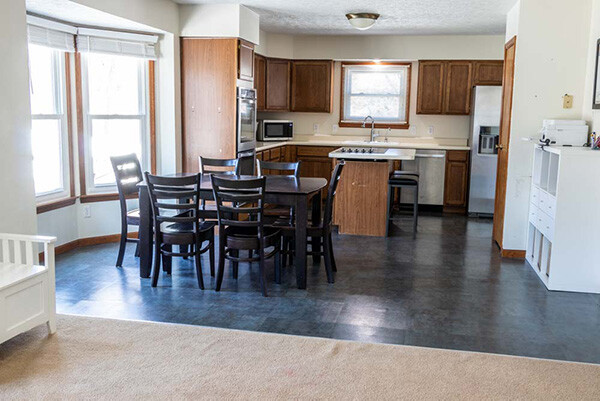In the summer of 2019, we bought a fixer-upper and paid off the temporary mortgage a few months later. The house and land were a step up in size for our family of six, but the condition of the home was a step (or several) down. We’re committed to renovating this house as we save up the necessary funds. Here are the pros and cons of living debt-free in a fixer-upper.
Table of Contents[Hide][Show]

Pros of Living Debt-Free in a Fixer-Upper
Pro #1: A Lower Purchase Price
The most obvious benefit of a fixer-upper is getting a deal. The only reason we could afford a home in this neighborhood was the much lower price point. We had set a conservative budget based on the projected sale price of our previous home and the money we had set aside in savings. But that lower budget and our wish list meant that we had few options to choose from.
Pro #2: Lower Competition When Buying
Homes that aren’t move-in ready are generally under less demand, especially if flipping the home won’t net much reward. Fortunately, this was the case for our fixer-upper. It was under contract when we first tried to see it, but it came back on the market a couple weeks later. Even though we were out of town at that time, it was still available when we returned. We could see the potential despite the obvious issues.
Pro #3: A Better Neighborhood (possibly)
A popular definition of a fixer-upper is the worst home in the best neighborhood. Although we enjoyed our previous home and neighborhood, we love our new neighborhood. Lot sizes are larger with more privacy. Living near two cul-de-sacs makes for little traffic. And sidewalks add to the feeling of safety and ambiance. The other houses in this neighborhood were above our budget and thus out of reach.
Pro #4: Guilt-Free Renovations (maybe)
If you’re like me, you might feel guilty about discarding something that is perfectly good but doesn’t fit your style. When we were house hunting, my wish list included a kitchen that either matched my taste or was in such poor condition that a complete remodel was justified. I didn’t want an updated kitchen in a style that I didn’t like because it would seem wasteful to remodel it.
Thankfully, my wish came true. Someday when our budget allows, I’ll get to redesign the kitchen with better storage, layout, materials, and style. Until then, I’ll work with what we’ve got and learn to be content – even if there is a gaping hole in the side of the island.
Pro #5: Time to Plan Updates and Renovations
Paying for renovations as you go means having the time to really consider which items to tackle on your to-do list first. Based on experience with our first home, I knew that our design ideas for this home would change over time. This happens because some pain points bubble to the top of the list faster than others. It also happens because you get to know your house and how you want to use it the longer you live in it.
Pro #6: Motivation to Hone DIY Skills
Large renovations are generally not budget friendly. We have some big ideas for our fixer-upper that may have to change or wait because of the sticker shock of the estimates we’ve received. More and more we’re considering how much we can do ourselves, and we’re trying to be creative in how we can accomplish our goals.
Pro #7: Satisfaction of a Job Well Done
It is truly satisfying to live in a home that you fixed up. We experienced this with our first home. I still love looking at the before and after pictures.





Cons of Living Debt-Free in a Fixer-Upper
Con #1: Taking Care of Major Issues First
A home that hasn’t been maintained well will have problems. While some issues are immediately obvious, others will pop up over time. We knew we had to replace the sump pump and kitchen floor, install a new water softener and filter, and repair the electricity to a bathroom. But other problems soon appeared that we weren’t expecting.
Had we not budgeted for known and unknown issues, we would have quickly depleted our resources and possibly gone into debt. Still, it was disheartening to spend our renovation funds, which we had hoped to put toward visual improvements, on mostly unseen items.
Con #2: Budget Constraints and Renovation Costs
Living debt-free in a fixer-upper means saving, waiting, and learning contentment. We dream big dreams about the changes we hope to make to our home, but those dreams will only become reality if we can pay for them outright. Receiving an estimate for a remodeling project that is much higher than anticipated not only delays progress but may also reduce the scope of potential changes.
Con #3: Dependencies
When one project depends on another, it’s hard to wait for the dependency to be resolved. Our entire house needs new flooring. Every carpet has red stains that won’t come out. The remaining flooring is worn and mismatched. We want to replace all the first-level flooring at the same time for a unified look, but first we need to remodel the kitchen. Similarly, we want to replace the upstairs carpeting, but we may convert the loft to a bedroom. Thus, the floors must wait for now so that we can have the cohesive look we want later.
We did make an exception for the kitchen floor since it was torn in many places. We chose an inexpensive vinyl tile to use in the meantime. Because we don’t want to reduce our budget or increase our wastefulness with more temporary floors, we’re making do with what we have in the rest of the house.
Con #4: Living in the Mess
There is no getting around the mess that comes with renovating a home while living in it. Possessions must be shifted around which not only disrupts routines but also creates clutter in other areas. DIY projects require supplies and space and may take longer than anticipated. Contractors do their best to keep a construction space tidy, but expect to dust and sweep more than usual.
Con #5: Honing Your DIY Skills
How can honing your DIY skills be a con of living debt-free in a fixer-upper while also being a pro? There are several reasons. Your DIY skills may not improve even after you get some practice under your belt. It can also be expensive to buy the tools and supplies necessary to try your hand at doing it yourself. Additionally, you may make mistakes that could compromise the integrity of your home.
Con #6: Longer Time Frame for Projects
Both living in a fixer-upper and having a fixed budget may lengthen the time frame required to complete projects. Because you are actively living in the home, you must likely devote more time to keeping the construction area tidy, especially if it is in a high traffic area. In addition, budget constraints may mean pausing a project due to an unexpected expense.
Con #7: Conflicting Emotions
Expect to have conflicting emotions when you live debt-free in a fixer-upper, especially at the beginning. On one hand, not having a mortgage is so freeing. On the other hand, not having the budget to make all of the necessary changes right away is defeating.
Con #8: Thought Consuming
Living in a fixer-upper will consume your thoughts. When you see the problem areas day in and day out, it’s difficult to stop yourself from constantly thinking about the changes you need to make. My husband and I talk about this on a regular basis. We must keep each other accountable so that we aren’t fixated on the problem areas of our home.
Living Debt-Free in a Fixer-Upper – Our Real-Life Progress
Year 1
A Clean Slate
When we received the keys to our fixer-upper, it was dirty. We spent the first two weeks of home ownership cleaning everything before moving in. I soon gave up hope on the toilets, so my husband replaced three of them during that time. In our exhaustion, we decided to postpone replacing the toilet in the basement.
A couple months later a service technician peeked under the shelf surround and informed us that the toilet was actually in the wall. What should have been a relatively easy fix of replacing the toilet now requires new drywall too. Since this project is not a priority, we just don’t use this bathroom.
During those first weeks, we also hired an electrician to fix the loss of power to the kids’ bathroom. Our plumber replaced the sump pump and mitigated a potential carbon monoxide issue with our water heater. My husband and father-in-law replaced the tattered kitchen floor, and I painted the pink laundry room a much calmer shade of blue.
Surprise Guests
Upon moving in, we soon learned that we had unwanted house guests. Mice! We attempted to trap them ourselves, but it was clear that we had a larger problem. On the advice of a friend, I called in a professional service that I now highly recommend. The knowledge of the mice prompted the removal of the drop-down basement ceiling as that held evidence of their previous existence.
Water Quality
We also realized that the water softener had not worked in quite some time. We replaced the water softener and added a reverse osmosis water filter that greatly improved the taste of the water.
Paint to the Rescue
The master bathroom was originally the color of Kraft macaroni and cheese. The skylight and wood tones of the vanity and flooring did not help this color choice. I painted the water closet first to make it less claustrophobic, and my husband finished painting the bathroom in a more peaceful light blue. Switching out the 1980s Hollywood lighting also helped. Someday we hope to gut this bathroom and truly transform it.


My husband also used paint to transform a rundown basement bedroom into a home office. In addition to painting the walls, he removed the carpet and painted the cement floor too. A new door and trim completed the simple renovation.
Pantry Shelves – A Surprising Pain Point
One of the pain points that quickly bubbled to the top was our pantry shelving. The existing wire shelves were not adjustable and there were too few of them. Even though we plan to gut the kitchen someday and remove the existing pantry, we decided to install a new shelving system. When the time comes to remodel the kitchen, we can easily relocate these shelves to the basement for additional storage in the workshop area.


Integral Systems
When winter came along, we discovered that our heater was damaged due to lack of a filter housing. Rather than pay an exorbitant repair cost, we opted to replace the entire HVAC system with a high efficiency unit. Given that we live in a fixer-upper, the contractor who actually believed me when I said it was okay to cut into walls or ceilings to have a better system won the bid. That’s not something they usually hear from clients.
I borrowed a digital radon tester from a friend and discovered that we also needed a radon mitigation system. It was a necessary expense for the long-term health of our family. We used the same company as we did for our previous home, so we knew what to expect.
Outdoors
Our yard is also a fixer-upper. It abounds with weeds, landscaping rocks, and tree stumps. My husband worked diligently to improve the flower beds at the front of the house, but we have a long way to go. The expansive deck at the rear of the home is nearing its end, but we don’t yet have a replacement plan or funds set aside for it. We did hire a tree company to remove five dead trees.
My husband and son tore down most of the dilapidated play set from the backyard. Only the swings remain. He spent much of the summer and early fall building a shed/playhouse where part of the play set used to be. We found the construction plans at Paul’s Sheds, and he enjoyed the time of working with his hands to improve our backyard.
Read More: Building a Backyard Shed {My DIY Story}
Year 2
Moving a Wall (and Much More)
When we bought our house, we didn’t love the open hallway leading to the laundry room. Behind it was an oversized half bath. This space also included a small bar sink and cabinets. Since we already had three other sinks (kitchen, half bathroom, and laundry room) in close proximity to this tiny sink, it didn’t make much since to keep it.

In our previous house, we removed a fireplace and replaced it with office built-ins. In this home, our dream was to move the wall in this hallway back a couple of feet and make the half bathroom behind it a normal size. Fortunately, it wasn’t a load bearing wall. Unfortunately, the HVAC stack from the basement to the second floor ran behind this wall as did some of the plumbing for the upstairs bathrooms.
After requesting a couple of quotes, we hired Korrect, a plumbing, heating, and air conditioning company, for this project. They had installed our HVAC system earlier that year and had the expertise needed for this job. In addition to shifting the HVAC stack and plumbing back, they also moved the rough-in locations of the toilet and the plumbing to the vanity. They built new walls around the HVAC and plumbing stack, properly vented the bathroom through the attic, moved electrical outlets and switches for us, and installed the new drywall.

Nearly two years later, we still need to paint the hallway and finish out the ceiling. That project is next on my list after completing our kids’ bathroom. We also need to plan for the built-ins that will go in this space.

Half Bath Remodel
As mentioned above, the half bathroom that we downsized in the hallway remodel was way bigger than necessary. The vanity had ample space around it. For some reason, the toilet was in a corner behind the door. See the complete half bathroom remodel reveal for before and after photos including the floor plan changes.

Better Closets
In late 2020, we also remodeled the closets in our kids’ rooms as well as the linen closet in the upstairs hallway. We had already used EasyClosets many times in the past, and we took advantage of a Black Friday sale.
We removed the old closets shelves and hanging rods and repaired and painted the walls. Then we installed the new closets to provide much better storage.
Small Linen Closet


Our Sons’ Closet


Our Daughter’s Closet


Year 3
New Lights
Our living room had a cathedral ceiling and no lights. Since this is also our homeschool room, adding lights sooner than later became a priority. We hired Bonham Electric to add six canless recessed downlights to our living room. In addition, they installed a new light over the tub in the kids’ bathroom and two new lights in our downstairs hallway where we will eventually add some built-in cabinets.
Kids’ Bathroom Remodel
In the spring of 2021, I went to Costco to buy groceries and came home with a bathroom vanity. That vanity then sat in waiting for another year as we didn’t begin this project until December 2021, and we didn’t complete it until late summer 2022. Check out the full story of our kids’ bathroom remodel and all of the before, during, and after photos.


Basement Bathroom Remodel
While my husband waited for me to do my part of our kids’ bathroom remodel, he got to work on our basement bathroom. Due to the toilet being in the wall, we hadn’t replaced it when we first moved in. Instead, we shut the door to the room and asked guests not to use it.


My husband removed the toilet, vanity, and flooring as well as the shower door. He patched several areas including the giant toilet-shaped hole in the wall and the hole in the ceiling that we had allowed the HVAC company to make when they installed our new system in 2020.


As we may do a more extensive remodel of this bathroom down the road, we chose not to spend a lot on new fixtures.
- The new toilet had to have a 10-inch trap to fit in the space, so we didn’t have many choices when replacing it.
- My husband repaired a broken vanity that we had received when we ordered a new vanity for our half bathroom. The company had sent a replacement and allowed us to keep the old one.
- The mirror came from a neighbor’s garage sale; we may paint it at a later date.
- We used the same flooring as the kids’ bathroom.
- The shower curtain is a hand-me-down from my sister, but I’ve always loved the simple design.
Is Living Debt-Free in a Fixer-Upper Right for You?
Now that you’ve read our account of living debt-free in a fixer-upper, do the pros outweigh the cons? Can you balance home life when you’re constantly surrounded by visual reminders of your to-do list? Will you be able to relax and find contentment in a fixer-upper? Check out this related article from This Old House for remodeling tips on a budget.

